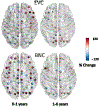Early Childhood Development of Node Centrality in the White Matter Connectome and Its Relationship to IQ at Age 6 Years
- PMID: 36162754
- PMCID: PMC10033460
- DOI: 10.1016/j.bpsc.2022.09.005
Early Childhood Development of Node Centrality in the White Matter Connectome and Its Relationship to IQ at Age 6 Years
Abstract
Background: The white matter (WM) connectome is important for cognitive development and intelligence and is altered in neuropsychiatric illnesses. Little is known about how the WM connectome develops or its relationship to IQ in early childhood.
Methods: The development of node centrality in the WM connectome was studied in a longitudinal cohort of 226 (123 female) children from the University of North Carolina Early Brain Development Study. Structural and diffusion-weighted images were acquired after birth and at 1, 2, 4, and 6 years, and IQ was assessed at 6 years. Eigenvector centrality, betweenness centrality, and the global graph metrics of global efficiency, small worldness, and modularity were determined at each age.
Results: The greatest developmental change in eigenvector centrality and betweenness centrality occurred during the first year of life, with relative stability between ages 1 and 6 years. Most of the high-centrality hubs at age 6 were also high-centrality hubs at 1 year, and many were already high-centrality hubs at birth. There were generally small but significant changes in global efficiency and modularity from birth to 6 years, while small worldness increased between 2 and 4 years. Individual node centrality was not significantly correlated with IQ at 6 years.
Conclusions: Node centrality in the WM connectome is established very early in childhood and is relatively stable from age 1 to 6 years. Many high-centrality hubs are established before birth, and most are present by age 1.
Keywords: Betweenness centrality; Brain networks; Cognitive development; Developmental trajectory; Diffusion-weighted imaging; Eigenvector centrality.
Copyright © 2022 Society of Biological Psychiatry. Published by Elsevier Inc. All rights reserved.
Conflict of interest statement
Financial Disclosure
All authors report no biomedical financial interests or potential conflicts of interest.
Figures





References
Publication types
MeSH terms
Grants and funding
LinkOut - more resources
Full Text Sources

